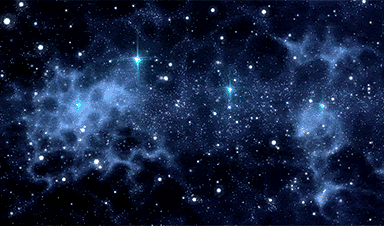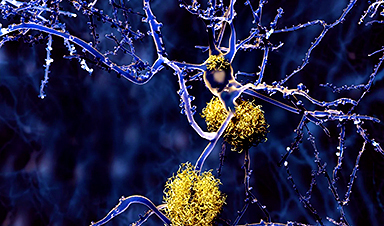Phase transition in early universe changes strength of interaction between dark and normal matter.
Dark matter remains one of the greatest mysteries of modern physics. It is clear that it must exist, because without dark matter, for example, the motion of galaxies cannot be explained. But it has never been possible to detect dark matter in an experiment.
Currently, there are many proposals for new experiments: They aim to detect dark matter directly via its scattering from the constituents of the atomic nuclei of a detection medium, i.e., protons and neutrons.
In the HYPER model, sometime after the formation of dark matter in the early universe, the strength of its interaction with normal matter increases abruptly—which on the one hand, makes it potentially detectable today and at the same time can explain the abundance of dark matter.
The new diversity in the dark matter sector
Since the search for heavy dark matter particles, or so-called WIMPS, has not yet led to success, the research community is looking for alternative dark matter particles, especially lighter ones. At the same time, one generically expects phase transitions in the dark sector—after all, there are several in the visible sector, the researchers say. But previous studies have tended to neglect them.
“There has not been a consistent dark matter model for the mass range that some planned experiments hope to access. “However, our HYPER model illustrates that a phase transition can actually help make the dark matter more easily detectable,” said Elor, a postdoctoral researcher in theoretical physics at JGU.
The challenge for a suitable model: If dark matter interacts too strongly with normal matter, its (precisely known) amount formed in the early universe would be too small, contradicting astrophysical observations. However, if it is produced in just the right amount, the interaction would conversely be too weak to detect dark matter in present-day experiments.
“Our central idea, which underlies the HYPER model, is that the interaction changes abruptly once—so we can have the best of both worlds: the right amount of dark matter and a large interaction so we might detect it,” McGehee said.
And this is how the researchers envision it: In particle physics, an interaction is usually mediated by a specific particle, a so-called mediator—and so is the interaction of dark matter with normal matter. Both the formation of dark matter and its detection function via this mediator, with the strength of the interaction depending on its mass: The larger the mass, the weaker the interaction.
The mediator must first be heavy enough so that the correct amount of dark matter is formed and later light enough so that dark matter is detectable at all. The solution: There was a phase transition after the formation of dark matter, during which the mass of the mediator suddenly decreased.
“Thus, on the one hand, the amount of dark matter is kept constant, and on the other hand, the interaction is boosted or strengthened in such a way that dark matter should be directly detectable,” Pierce said.
New model covers almost the full parameter range of planned experiments
“The HYPER model of dark matter is able to cover almost the entire range that the new experiments make accessible,” Elor said.
Specifically, the research team first considered the maximum cross-section of the mediator-mediated interaction with the protons and neutrons of an atomic nucleus to be consistent with astrological observations and certain particle-physics decays. The next step was to consider whether there was a model for dark matter that exhibited this interaction.
“And here we came up with the idea of the phase transition,” McGehee said. “We then calculated the amount of dark matter that exists in the universe and then simulated the phase transition using our calculations.”
There are a great many constraints to consider, such as a constant amount of dark matter.
“Here, we have to systematically consider and include very many scenarios, for example, asking the question whether it is really certain that our mediator does not suddenly lead to the formation of new dark matter, which of course must not be,” Elor said. “But in the end, we were convinced that our HYPER model works.”
The research is published in the journal Physical Review Letters.
News
Baffling Scientists for Centuries: New Study Unravels Mystery of Static Electricity
ISTA physicists demonstrate that contact electrification depends on the contact history of materials. For centuries, static electricity has intrigued and perplexed scientists. Now, researchers from the Waitukaitis group at the Institute of Science and [...]
Tumor “Stickiness” – Scientists Develop Potential New Way To Predict Cancer’s Spread
UC San Diego researchers have developed a device that predicts breast cancer aggressiveness by measuring tumor cell adhesion. Weakly adherent cells indicate a higher risk of metastasis, especially in early-stage DCIS. This innovation could [...]
Scientists Just Watched Atoms Move for the First Time Using AI
Scientists have developed a groundbreaking AI-driven technique that reveals the hidden movements of nanoparticles, essential in materials science, pharmaceuticals, and electronics. By integrating artificial intelligence with electron microscopy, researchers can now visualize atomic-level changes that were [...]
Scientists Sound Alarm: “Safe” Antibiotic Has Led to an Almost Untreatable Superbug
A recent study reveals that an antibiotic used for liver disease patients may increase their risk of contracting a dangerous superbug. An international team of researchers has discovered that rifaximin, a commonly prescribed antibiotic [...]
Scientists Discover Natural Compound That Stops Cancer Progression
A discovery led by OHSU was made possible by years of study conducted by University of Portland undergraduates. Scientists have discovered a natural compound that can halt a key process involved in the progression [...]
Scientists Just Discovered an RNA That Repairs DNA Damage – And It’s a Game-Changer
Our DNA is constantly under threat — from cell division errors to external factors like sunlight and smoking. Fortunately, cells have intricate repair mechanisms to counteract this damage. Scientists have uncovered a surprising role played by [...]
What Scientists Just Discovered About COVID-19’s Hidden Death Toll
COVID-19 didn’t just claim lives directly—it reshaped mortality patterns worldwide. A major international study found that life expectancy plummeted across most of the 24 analyzed countries, with additional deaths from cardiovascular disease, substance abuse, and mental [...]
Self-Propelled Nanoparticles Improve Immunotherapy for Non-Invasive Bladder Cancer
A study led by Pohang University of Science and Technology (POSTECH) and the Institute for Bioengineering of Catalonia (IBEC) in South Korea details the creation of urea-powered nanomotors that enhance immunotherapy for bladder cancer. The nanomotors [...]
Scientists Develop New System That Produces Drinking Water From Thin Air
UT Austin researchers have developed a biodegradable, biomass-based hydrogel that efficiently extracts drinkable water from the air, offering a scalable, sustainable solution for water access in off-grid communities, emergency relief, and agriculture. Discarded food [...]
AI Unveils Hidden Nanoparticles – A Breakthrough in Early Disease Detection
Deep Nanometry (DNM) is an innovative technique combining high-speed optical detection with AI-driven noise reduction, allowing researchers to find rare nanoparticles like extracellular vesicles (EVs). Since EVs play a role in disease detection, DNM [...]
Inhalable nanoparticles could help treat chronic lung disease
Nanoparticles designed to release antibiotics deep inside the lungs reduced inflammation and improved lung function in mice with symptoms of chronic obstructive pulmonary disease By Grace Wade Delivering medication to the lungs with inhalable nanoparticles [...]
New MRI Study Uncovers Hidden Lung Abnormalities in Children With Long COVID
Long COVID is more than just lingering symptoms—it may have a hidden biological basis that standard medical tests fail to detect. A groundbreaking study using advanced MRI technology has uncovered significant lung abnormalities in [...]
AI Struggles with Abstract Thought: Study Reveals GPT-4’s Limits
While GPT-4 performs well in structured reasoning tasks, a new study shows that its ability to adapt to variations is weak—suggesting AI still lacks true abstract understanding and flexibility in decision-making. Artificial Intelligence (AI), [...]
Turning Off Nerve Signals: Scientists Develop Promising New Pancreatic Cancer Treatment
Pancreatic cancer reprograms nerve cells to fuel its growth, but blocking these connections can shrink tumors and boost treatment effectiveness. Pancreatic cancer is closely linked to the nervous system, according to researchers from the [...]
New human antibody shows promise for Ebola virus treatment
New research led by scientists at La Jolla Institute for Immunology (LJI) reveals the workings of a human antibody called mAb 3A6, which may prove to be an important component for Ebola virus therapeutics. [...]
Early Alzheimer’s Detection Test – Years Before Symptoms Appear
A new biomarker test can detect early-stage tau protein clumping up to a decade before it appears on brain scans, improving early Alzheimer’s diagnosis. Unlike amyloid-beta, tau neurofibrillary tangles are directly linked to cognitive decline. Years [...]






















